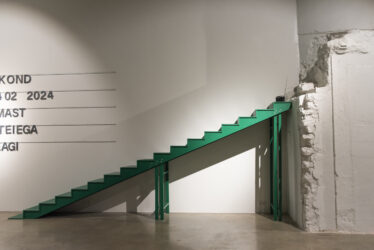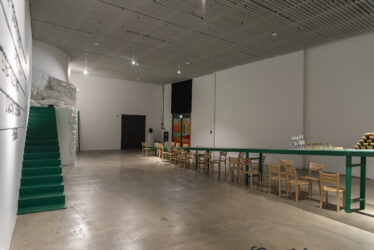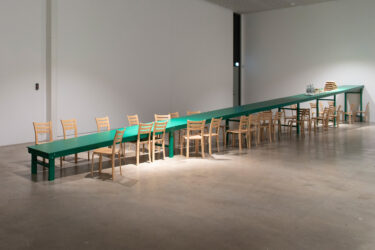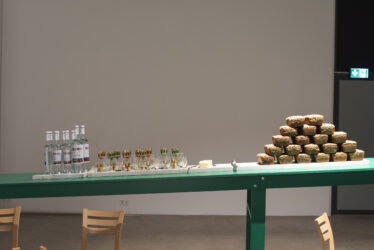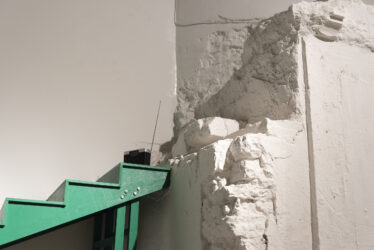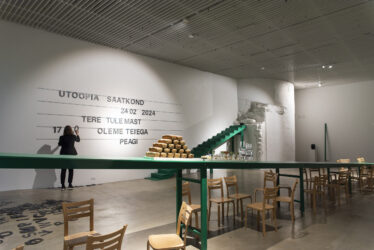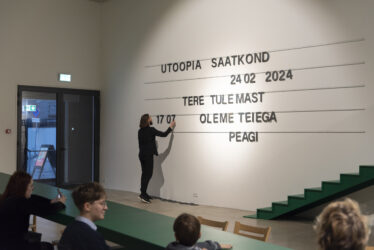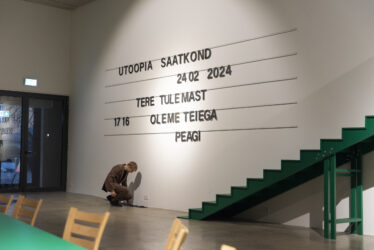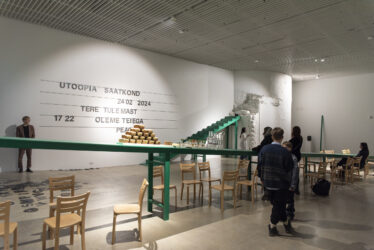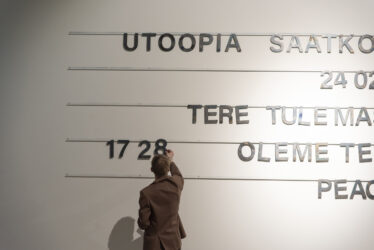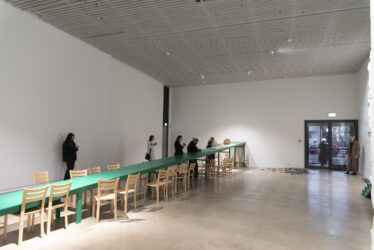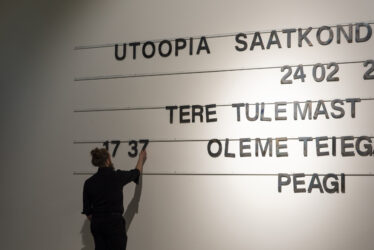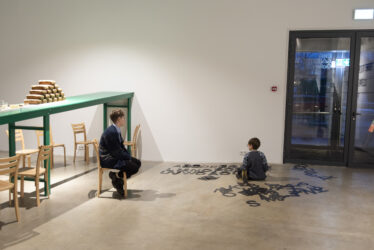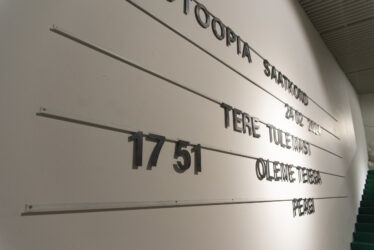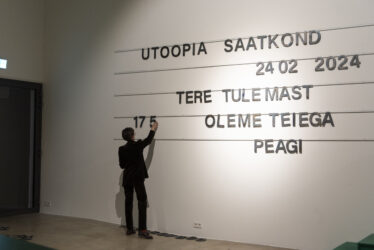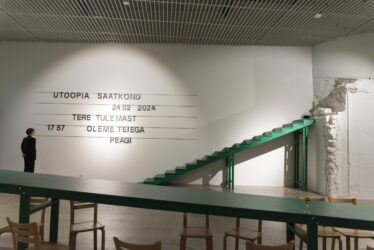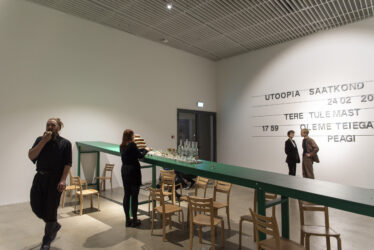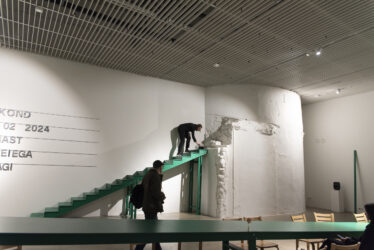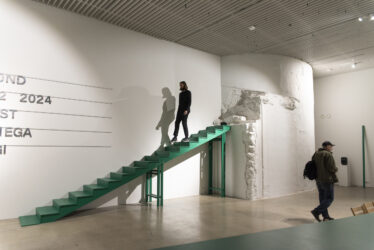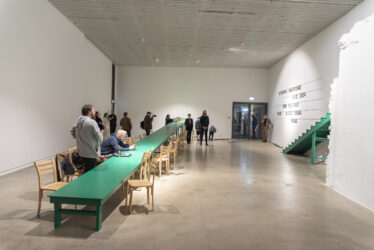Exhibitions
19.02.2024 — 24.02.2024
Durational performance “The Embassy of Utopia” at EKA Gallery 19.–24.02.2024
“The Embassy of Utopia: Happiness for Everybody, Free of Charge, and May No One Be Left Behind!*”
EKA Gallery
19.–24.02.2024
Open Mon–Fri 12–9 pm & Sat 5–11 pm (part of the reception), free entry
The Institute of Meetings & Non-Meetings opens the Embassy of Utopia at the EKA Gallery on February 19th. On the final evening of the performative installation, February 24th, one hour after President Alar Karis steps up to the lectern at the Estonia Theatre to deliver Estonia’s most anticipated speech of the year, the Embassy of Utopia will present the year’s most unexpected speech.
The speech will not be written by artificial intelligence or a freelance poet. It will be written by those who gather at the Embassy, those seeking poetic refuge.
“We have dealt with speeches in the Institute’s and Paide Theatre’s previous projects and confirmed that the core of a good speech is a clear message. But the world is not clear, and it seems that every speech, aiming to bring clarity, spreads confusion. Therefore, we decided it was time to turn our backs on clarity and create a speech that acknowledges confusion,” says one of the participating artists, Jan Teevet.
“One might ask, what distinguishes the Embassy of Utopia’s speech from any much-maligned internet forum. The answer can be found in the phenomenon of meeting. From Monday to Friday, when the Embassy’s doors at the Estonian Academy of Arts are open to all passersby, dozens of groups will meet there, not aiming for a mediocre compromise, but to build bold connections between views, crises, and solutions that frame their personal realities today,” adds the Institute’s dramaturge, Oliver Issak.
“A clear message, a clear tax system, a clear line between good and evil — we often think that clarity takes care of everything and everyone on its own, not noticing that clarity can often be uncaring. Clear messages are easier to receive and categorize, but how to organise a reception for doubts?” asks sociologist and artist-researcher Margaret Tilk.
The Embassy of Utopia is open from February 19th–23rd from 12–9 pm and culminates in the Embassy of Utopia’s reception on February 24th at 5 pm.
Entry to the Embassy is free for all, and everyone is free to decide whether it is an exhibition, a theatre production, a workshop, a meeting, a political-poetic consecration, a deep hangout, a minimalist opera, or something else entirely. One may also choose not to decide.
The Embassy of Utopia’s daily life and nightly fiction are created and organised by Oliver Issak, Kairi Mändla, Jan Teevet, Taavi Teevet, and Margaret Tilk.
“The Embassy of Utopia: Happiness for everybody, free of charge, and may no one be left behind!” is the fourth event in the series of actions created by the Institute of Meetings and Non-Meetings. The doors of the Embassy of Utopia first opened in May 2023 at the invitation of the international literature festival Prima Vista and the European Capital of Culture Tartu 2024, with the subtitle “Longing for a different reality”, and from September, the Embassy of Utopia’s radio action goes live on Klassikaraadio on the last Sunday of every month. On December 31st, 2023, a 5-hour New Year’s Eve special was broadcasted on Klassikaraadio’s wavelength, “Embassy of Utopia: A Thousand Toasts to the Future”.
The Embassy of Utopia is a sanctuary for positive uncertainty, bold thought, and untamable imagination.
* The title is based on the novel “Roadside Picnic” by Arkady and Boris Strugatsky.
The project is supported by the Cultural Endowment of Estonia.
Drinks at the reception provided by Põhjala Brewery.
More info:
Jan Teevet jan@instituut.art
Oliver Issak oliver@instituut.art
Margaret Tilk marga.tilk@gmail.com
www.instituut.art/utoopiasaatkond
Durational performance “The Embassy of Utopia” at EKA Gallery 19.–24.02.2024
Monday 19 February, 2024 — Saturday 24 February, 2024
“The Embassy of Utopia: Happiness for Everybody, Free of Charge, and May No One Be Left Behind!*”
EKA Gallery
19.–24.02.2024
Open Mon–Fri 12–9 pm & Sat 5–11 pm (part of the reception), free entry
The Institute of Meetings & Non-Meetings opens the Embassy of Utopia at the EKA Gallery on February 19th. On the final evening of the performative installation, February 24th, one hour after President Alar Karis steps up to the lectern at the Estonia Theatre to deliver Estonia’s most anticipated speech of the year, the Embassy of Utopia will present the year’s most unexpected speech.
The speech will not be written by artificial intelligence or a freelance poet. It will be written by those who gather at the Embassy, those seeking poetic refuge.
“We have dealt with speeches in the Institute’s and Paide Theatre’s previous projects and confirmed that the core of a good speech is a clear message. But the world is not clear, and it seems that every speech, aiming to bring clarity, spreads confusion. Therefore, we decided it was time to turn our backs on clarity and create a speech that acknowledges confusion,” says one of the participating artists, Jan Teevet.
“One might ask, what distinguishes the Embassy of Utopia’s speech from any much-maligned internet forum. The answer can be found in the phenomenon of meeting. From Monday to Friday, when the Embassy’s doors at the Estonian Academy of Arts are open to all passersby, dozens of groups will meet there, not aiming for a mediocre compromise, but to build bold connections between views, crises, and solutions that frame their personal realities today,” adds the Institute’s dramaturge, Oliver Issak.
“A clear message, a clear tax system, a clear line between good and evil — we often think that clarity takes care of everything and everyone on its own, not noticing that clarity can often be uncaring. Clear messages are easier to receive and categorize, but how to organise a reception for doubts?” asks sociologist and artist-researcher Margaret Tilk.
The Embassy of Utopia is open from February 19th–23rd from 12–9 pm and culminates in the Embassy of Utopia’s reception on February 24th at 5 pm.
Entry to the Embassy is free for all, and everyone is free to decide whether it is an exhibition, a theatre production, a workshop, a meeting, a political-poetic consecration, a deep hangout, a minimalist opera, or something else entirely. One may also choose not to decide.
The Embassy of Utopia’s daily life and nightly fiction are created and organised by Oliver Issak, Kairi Mändla, Jan Teevet, Taavi Teevet, and Margaret Tilk.
“The Embassy of Utopia: Happiness for everybody, free of charge, and may no one be left behind!” is the fourth event in the series of actions created by the Institute of Meetings and Non-Meetings. The doors of the Embassy of Utopia first opened in May 2023 at the invitation of the international literature festival Prima Vista and the European Capital of Culture Tartu 2024, with the subtitle “Longing for a different reality”, and from September, the Embassy of Utopia’s radio action goes live on Klassikaraadio on the last Sunday of every month. On December 31st, 2023, a 5-hour New Year’s Eve special was broadcasted on Klassikaraadio’s wavelength, “Embassy of Utopia: A Thousand Toasts to the Future”.
The Embassy of Utopia is a sanctuary for positive uncertainty, bold thought, and untamable imagination.
* The title is based on the novel “Roadside Picnic” by Arkady and Boris Strugatsky.
The project is supported by the Cultural Endowment of Estonia.
Drinks at the reception provided by Põhjala Brewery.
More info:
Jan Teevet jan@instituut.art
Oliver Issak oliver@instituut.art
Margaret Tilk marga.tilk@gmail.com
www.instituut.art/utoopiasaatkond
29.02.2024 — 10.03.2024
Young Sculptor Award Exhibition 2024
On February 29 at 4:00 pm, the Young Sculptor Award Exhibition 2024 of the Department of Installation and Sculpture of the Estonian Academy of Arts will open at EKKM.
The winner of the Young Sculptor Award 2024 will be announced at the exhibition opening. The award winner will be selected by a 5-member jury independent of the organisers. The competition is open to individual authors with a work completed in 2023, a development of a work completed in 2023 or a new work in the making.
This time, the jury of the Young Sculptor Award 2024 selected 15 works from the 39 entries received.
The nominees are Sandra Ernits, Iohan Figueroa, Chloé Geinoz, Aurelia Grace Talmon, Erik Hõim, Loora Kaubi, Ellen Emilie Laaksonen, Noah Emanuel Morrison, Sarah Noonan, Elise Marie Olesk, KitKit Para, Inessa Saarits, Asmus Soodla, Sonja Sutt and Ats- Anton Varustin.
The Young Sculptor Award and the accompanying exhibition, launched in 2012, aim to highlight and recognise the professional work of young artists working in the field of sculpture and installation.
Previous winners of the Young Sculptor Award include Hanna Piksarv, Sten Saarits, Anna Mari Liivrand, Johannes Valdma, Rosa Violetta Grötsch, Johannes Luik, Siim Elmers, Sarah Nõmm, Junny Yeung and Mara Kirchberg.
The exhibition is open until 10 March, daily from 2pm to 8pm.
The exhibition is supported by the Estonian Academy of Arts, the Cultural Endowment of Estonia, Põhjala Brewery and Karksi Brewery.
Graphic design by Cristopher Siniväli
Young Sculptor Award Exhibition 2024
Thursday 29 February, 2024 — Sunday 10 March, 2024
On February 29 at 4:00 pm, the Young Sculptor Award Exhibition 2024 of the Department of Installation and Sculpture of the Estonian Academy of Arts will open at EKKM.
The winner of the Young Sculptor Award 2024 will be announced at the exhibition opening. The award winner will be selected by a 5-member jury independent of the organisers. The competition is open to individual authors with a work completed in 2023, a development of a work completed in 2023 or a new work in the making.
This time, the jury of the Young Sculptor Award 2024 selected 15 works from the 39 entries received.
The nominees are Sandra Ernits, Iohan Figueroa, Chloé Geinoz, Aurelia Grace Talmon, Erik Hõim, Loora Kaubi, Ellen Emilie Laaksonen, Noah Emanuel Morrison, Sarah Noonan, Elise Marie Olesk, KitKit Para, Inessa Saarits, Asmus Soodla, Sonja Sutt and Ats- Anton Varustin.
The Young Sculptor Award and the accompanying exhibition, launched in 2012, aim to highlight and recognise the professional work of young artists working in the field of sculpture and installation.
Previous winners of the Young Sculptor Award include Hanna Piksarv, Sten Saarits, Anna Mari Liivrand, Johannes Valdma, Rosa Violetta Grötsch, Johannes Luik, Siim Elmers, Sarah Nõmm, Junny Yeung and Mara Kirchberg.
The exhibition is open until 10 March, daily from 2pm to 8pm.
The exhibition is supported by the Estonian Academy of Arts, the Cultural Endowment of Estonia, Põhjala Brewery and Karksi Brewery.
Graphic design by Cristopher Siniväli
02.02.2024 — 03.03.2024
Lepik and Purtsak the Monumental Gallery of the Tartu Art House
On Friday, 2 February at 5 p.m., the joint exhibition “Urge“ by Lisette Lepik and Brenda Purtsak will open in the monumental gallery of the Tartu Art House.
The curator of the exhibition is Kerly Ritval.
The exhibition brings together the artists and the curator to examine the diverse and mysterious nature of love. They explore boundaries and express in art what drives and fulfils human life: love.
Love can’t be truly expressed in words, is invisible to the eye, and is intangible, making it difficult to find, hold onto and let go of. It accompanies a person throughout life as a strongly beating urge.
The curator explains: “Brenda Purtsak’s artistic practice engages with the human body, drawing inspiration, among other things, directly from the operating table. By dissecting the human body with colours, she seeks answers to larger existential questions, such as: What is the biological force in the human body that pushes and pulls us toward each other? Lisette Lepik’s painting practice has focused on the body, sensations, sexuality and related traumas. In this exhibition, the artist expresses thoughts, feelings and fears related to love through her distinctive colour, composition and form language.”
The exhibition invites viewers on an introspective journey and into contemplation about desire, love, touch and fears, as well as the absence of love, searching and discoveries.
Brenda Purtsak (b. 1994) is an Estonian artist who graduated from the Estonian Academy of Arts with a master’s degree in Contemporary Art (2022) and a bachelor’s degree in Painting (2020). She has been working as a lecturer at the Academy since 2023.
Lisette Lepik (b. 1999) is an Estonian artist based in Tallinn. She graduated with a bachelor’s degree in painting from the Estonian Academy of Arts (2022) and furthered her studies in installation art at the Icelandic Academy of the Arts (2019). Since 2023, she has been working as a lecturer at the Estonian Academy of Arts.
Kerly Ritval (b. 1996) is an Estonian curator and critic who completed a bachelor’s degree in art history and visual culture studies (2020) and a master’s degree in curatorial studies at the Estonian Academy of Arts (2023). She also supplemented her curatorial studies in Iceland (2022) and recently furthered her education in New York, assisting in producing the performance biennial Performa (2023).
Graphic designer: Rainer Kasekivi
Poetry used in the exhibition by Andres Anissimov
The exhibition is supported by the Estonian Cultural Endowment and the city of Tartu.
The exhibition will remain open until 3 March.
Lepik and Purtsak the Monumental Gallery of the Tartu Art House
Friday 02 February, 2024 — Sunday 03 March, 2024
On Friday, 2 February at 5 p.m., the joint exhibition “Urge“ by Lisette Lepik and Brenda Purtsak will open in the monumental gallery of the Tartu Art House.
The curator of the exhibition is Kerly Ritval.
The exhibition brings together the artists and the curator to examine the diverse and mysterious nature of love. They explore boundaries and express in art what drives and fulfils human life: love.
Love can’t be truly expressed in words, is invisible to the eye, and is intangible, making it difficult to find, hold onto and let go of. It accompanies a person throughout life as a strongly beating urge.
The curator explains: “Brenda Purtsak’s artistic practice engages with the human body, drawing inspiration, among other things, directly from the operating table. By dissecting the human body with colours, she seeks answers to larger existential questions, such as: What is the biological force in the human body that pushes and pulls us toward each other? Lisette Lepik’s painting practice has focused on the body, sensations, sexuality and related traumas. In this exhibition, the artist expresses thoughts, feelings and fears related to love through her distinctive colour, composition and form language.”
The exhibition invites viewers on an introspective journey and into contemplation about desire, love, touch and fears, as well as the absence of love, searching and discoveries.
Brenda Purtsak (b. 1994) is an Estonian artist who graduated from the Estonian Academy of Arts with a master’s degree in Contemporary Art (2022) and a bachelor’s degree in Painting (2020). She has been working as a lecturer at the Academy since 2023.
Lisette Lepik (b. 1999) is an Estonian artist based in Tallinn. She graduated with a bachelor’s degree in painting from the Estonian Academy of Arts (2022) and furthered her studies in installation art at the Icelandic Academy of the Arts (2019). Since 2023, she has been working as a lecturer at the Estonian Academy of Arts.
Kerly Ritval (b. 1996) is an Estonian curator and critic who completed a bachelor’s degree in art history and visual culture studies (2020) and a master’s degree in curatorial studies at the Estonian Academy of Arts (2023). She also supplemented her curatorial studies in Iceland (2022) and recently furthered her education in New York, assisting in producing the performance biennial Performa (2023).
Graphic designer: Rainer Kasekivi
Poetry used in the exhibition by Andres Anissimov
The exhibition is supported by the Estonian Cultural Endowment and the city of Tartu.
The exhibition will remain open until 3 March.
24.01.2024 — 17.02.2024
Melnikova, Keskküla, Monko, Daniliauskaitė at Draakon Gallery
On Wednesday, January 24 at 6 pm we welcome you to the opening of the exhibition Swirling, Twirling, Spinning curated by Merilin Talumaa.
The exhibition includes works by Daria Melnikova, Helena Keskküla, Marge Monko and Viktorija Daniliauskaitė.
The exhibition Swirling, Twirling, Spinning unites artists across generations in an empowering context, drawing inspiration from the ideas of Lithuanian-American archaeologist and anthropologist Marija Gimbutas. Her profound research brought attention to the ancient cultures of the Baltic region and the broader Indo-European world, exploring archaeological artefacts, linguistics, ethnography, and folklore. Gimbutas posited a thesis that prehistoric European culture centered around the worship of a Mother Goddess, as the giver of all life. A spiritual sense of connectedness was artfully expressed through a sophisticated symbol system and an abundance of ritual objects. Nature and body were honored in Europe for tens of thousands of years. Whereas women had an especially strong position in societies across Eastern and Central Europe – a tendency no longer necessarily evident today.
Swirling, Twirling, Spinning poetically weaves a narrative that bridges ancient myths and beliefs, natural cycles, and the transformative power of feminine energy across different cultures and times. Gimbutas, who having opened the treasure trove of prehistory, inspired a belief in a peaceful existence in our time – to bring back to life suppressed vital elements, such as the earth, the body (health), the feminine, and the subconscious. Participating artists, through imaginative and fictitious narratives, share personal stories and cultural myths that also reflect the influence of Gimbutas’ theories on ancient symbolism. Their works echo these concepts through a contemporary lens, incorporating elements such as spirals, circles, and motifs such as snakes and birds – symbols rooted in ancient European matriarchal cultures that continue to resonate in Baltic art and culture.
The exhibition contemplates on reimagining a world centered around goddess worship, with its emphasis on embracing womanhood, preserving nature, and forsaking warfare. Could this theoretical concept transcend into the tangible reality of our future society? Swirling, Twirling, Spinning seamlessly intertwines historical narratives and mythology, immersing us in the themes that Marija Gimbutas ignited: the celebration of life’s cycles, constant renewal, the sanctity of the female body, and the spirituality inherent in these concepts. Gimbutas’ exploration of the spiritual dimensions of a harmonious Old Europe and her vision for a New Europe free from dominance and warfare, feels remarkably pertinent in our contemporary world.
First exhibition around the heritage of Marija Gimbutas took place in L’Atlas Gallery in Paris, France (7 November 2023–3 January 2024). The cycle of exhibitions is foreseen to continue with an upcoming show in La Traverse in Marseille, France (27 August–26 October 2024).
Marija Gimbutas (1921–1994) was a Lithuanian-American archaeologist and anthropologist. She contributed to what is considered to be one of the most significant academic watershed moments in women’s studies with her archaeological and philosophical work on Neolithic culture and religion. Gimbutas is best known for her research into the Neolithic and Bronze Age cultures of “Old Europe,” a term she introduced. Old Europe referred to both the geographical area and social structures that existed before the Indo-European influence. Gimbutas unequivocally established the existence of a Goddess religion who is the most persistent feature in the archaeological record of the ancient world. The Goddess in all her manifestations was a symbol of the unity of all life in nature. Gimbutas’ discoveries took on great symbolic importance for feminists across various disciplines who found, in her vision of a peaceful, nature-revering society, a sense of hope for the future based on this foundation in the distant past.
Roots to Routes is an initiative created by curators Merilin Talumaa, Maija Rudovska and Justė Kostikovaitė, gathering a community of artists, curators and cultural producers whose trajectories are connected to the Baltic states region. Acting as a nomadic agency, its goal is to support and make visible artistic practices beyond cultural and (geo)political borders. An important part of the collaboration is to create and develop possible joint projects, aiming to build sustainable networks and forms of cooperation between various art scenes.
https://roots2routes.org/
Exhibitions in Draakon gallery are supported by the Cultural Endowment of Estonia, Estonian Ministry of Culture and Liviko AS.
Melnikova, Keskküla, Monko, Daniliauskaitė at Draakon Gallery
Wednesday 24 January, 2024 — Saturday 17 February, 2024
On Wednesday, January 24 at 6 pm we welcome you to the opening of the exhibition Swirling, Twirling, Spinning curated by Merilin Talumaa.
The exhibition includes works by Daria Melnikova, Helena Keskküla, Marge Monko and Viktorija Daniliauskaitė.
The exhibition Swirling, Twirling, Spinning unites artists across generations in an empowering context, drawing inspiration from the ideas of Lithuanian-American archaeologist and anthropologist Marija Gimbutas. Her profound research brought attention to the ancient cultures of the Baltic region and the broader Indo-European world, exploring archaeological artefacts, linguistics, ethnography, and folklore. Gimbutas posited a thesis that prehistoric European culture centered around the worship of a Mother Goddess, as the giver of all life. A spiritual sense of connectedness was artfully expressed through a sophisticated symbol system and an abundance of ritual objects. Nature and body were honored in Europe for tens of thousands of years. Whereas women had an especially strong position in societies across Eastern and Central Europe – a tendency no longer necessarily evident today.
Swirling, Twirling, Spinning poetically weaves a narrative that bridges ancient myths and beliefs, natural cycles, and the transformative power of feminine energy across different cultures and times. Gimbutas, who having opened the treasure trove of prehistory, inspired a belief in a peaceful existence in our time – to bring back to life suppressed vital elements, such as the earth, the body (health), the feminine, and the subconscious. Participating artists, through imaginative and fictitious narratives, share personal stories and cultural myths that also reflect the influence of Gimbutas’ theories on ancient symbolism. Their works echo these concepts through a contemporary lens, incorporating elements such as spirals, circles, and motifs such as snakes and birds – symbols rooted in ancient European matriarchal cultures that continue to resonate in Baltic art and culture.
The exhibition contemplates on reimagining a world centered around goddess worship, with its emphasis on embracing womanhood, preserving nature, and forsaking warfare. Could this theoretical concept transcend into the tangible reality of our future society? Swirling, Twirling, Spinning seamlessly intertwines historical narratives and mythology, immersing us in the themes that Marija Gimbutas ignited: the celebration of life’s cycles, constant renewal, the sanctity of the female body, and the spirituality inherent in these concepts. Gimbutas’ exploration of the spiritual dimensions of a harmonious Old Europe and her vision for a New Europe free from dominance and warfare, feels remarkably pertinent in our contemporary world.
First exhibition around the heritage of Marija Gimbutas took place in L’Atlas Gallery in Paris, France (7 November 2023–3 January 2024). The cycle of exhibitions is foreseen to continue with an upcoming show in La Traverse in Marseille, France (27 August–26 October 2024).
Marija Gimbutas (1921–1994) was a Lithuanian-American archaeologist and anthropologist. She contributed to what is considered to be one of the most significant academic watershed moments in women’s studies with her archaeological and philosophical work on Neolithic culture and religion. Gimbutas is best known for her research into the Neolithic and Bronze Age cultures of “Old Europe,” a term she introduced. Old Europe referred to both the geographical area and social structures that existed before the Indo-European influence. Gimbutas unequivocally established the existence of a Goddess religion who is the most persistent feature in the archaeological record of the ancient world. The Goddess in all her manifestations was a symbol of the unity of all life in nature. Gimbutas’ discoveries took on great symbolic importance for feminists across various disciplines who found, in her vision of a peaceful, nature-revering society, a sense of hope for the future based on this foundation in the distant past.
Roots to Routes is an initiative created by curators Merilin Talumaa, Maija Rudovska and Justė Kostikovaitė, gathering a community of artists, curators and cultural producers whose trajectories are connected to the Baltic states region. Acting as a nomadic agency, its goal is to support and make visible artistic practices beyond cultural and (geo)political borders. An important part of the collaboration is to create and develop possible joint projects, aiming to build sustainable networks and forms of cooperation between various art scenes.
https://roots2routes.org/
Exhibitions in Draakon gallery are supported by the Cultural Endowment of Estonia, Estonian Ministry of Culture and Liviko AS.
17.01.2024 — 26.01.2024
Nua Collective at Vent Space
BLACKOUT
Opening 17th January 2024 at 7pm (EET)
Running until January 26th 2024
Scattered around the world, Nua Collective are a group of professional visual artists that collaborate together to create, share and support one another in their journey as artists. Blackout marks their first physical exhibition and they are delighted to continue their international tour in Vent Space.
Presenting the works of 13 Nua Collective artists, the Blackout series looks at climate change through a particular lens—blackout. Or the loss of self security that comes from our reliance on unreliable energy. The works wrestle with our human responses to the insecurity inflicted by the anthropomorphic blackout. This exhibition of lino prints that are unique and in their creation and processing have already travelled the globe and will also feature the premiere of the Blackout Documentary screened at the space throughout the exhibition run.
Together Nua Collective artists make an inquiry about our climate catastrophe and the energy crisis that we continue to face.
Nua Collective at Vent Space
Wednesday 17 January, 2024 — Friday 26 January, 2024
BLACKOUT
Opening 17th January 2024 at 7pm (EET)
Running until January 26th 2024
Scattered around the world, Nua Collective are a group of professional visual artists that collaborate together to create, share and support one another in their journey as artists. Blackout marks their first physical exhibition and they are delighted to continue their international tour in Vent Space.
Presenting the works of 13 Nua Collective artists, the Blackout series looks at climate change through a particular lens—blackout. Or the loss of self security that comes from our reliance on unreliable energy. The works wrestle with our human responses to the insecurity inflicted by the anthropomorphic blackout. This exhibition of lino prints that are unique and in their creation and processing have already travelled the globe and will also feature the premiere of the Blackout Documentary screened at the space throughout the exhibition run.
Together Nua Collective artists make an inquiry about our climate catastrophe and the energy crisis that we continue to face.
06.01.2024 — 07.02.2024
Tim Daniel Suvi & Anu Antsi at Galerii Metropol
Anu Antsi anuantsi@gmail.com
Kaarel Kütas +372 5217649, kaarel.kytas@gmail.com or Triinu Jürves triyrves@gmail.com
FB: Metropol galerii
IG: metropolkapp
Metropol in NOBA art map: noba.ac/et/galerii/galerii-metropol-6m2-metropol-kapp/
Tim Daniel Suvi & Anu Antsi at Galerii Metropol
Saturday 06 January, 2024 — Wednesday 07 February, 2024
Anu Antsi anuantsi@gmail.com
Kaarel Kütas +372 5217649, kaarel.kytas@gmail.com or Triinu Jürves triyrves@gmail.com
FB: Metropol galerii
IG: metropolkapp
Metropol in NOBA art map: noba.ac/et/galerii/galerii-metropol-6m2-metropol-kapp/
29.12.2023 — 22.01.2024
Sten Saarits at Hobusepea Gallery
On Friday, December 29 at 6 pm we open the solo exhibition “It will take approximately 25 minutes to experience this exhibition, we apologize for any inconvenience” by Sten Saarits. The exhibition will remain open until January 22, 2024.
How much of our valuable time do we unconsciously give for nothing, without receiving anything in return.. Like drifting obliviously, without noticing the surroundings and those around us. The desire to belong is fundamentally a basic human need. Studies suggest that the craving for social interactions arise from the same region of the brain where our need for food is felt, and when we are excluded, the experience is processed in the same brain region responsible for the sensation of physical pain.. And then we activate. Like toys with new batteries. Panic-induced false belonging sets in, and smart devices play a significant role in fulfilling the basic need for connection. The somewhat unsettling sense of non-belonging paves the way for digital non-spaces and fantastic, theatrical realms within it. Humans have the essential need to observe and be observed.. To be seen, heard and considered by others. It is safe to move in packs, each one still lonely, eyes staring to the non-world.. because the possibility for non-world is always present; it is nowhere and belongs to no one.. There is no accountability, neither for actions nor for consequences, I do not participate, I am just an observer.. Slightly calming, somewhat entertaining, but excellent for passing the time.
Our desire to belong pushes us to action, but it cannot happen without sacrifice. Am I willing though.. These are my experiences, my belongings, my people, my thoughts and feelings.. What if the new ones are not coming.. Will I remain stranded here, idle and free-falling in the middle world.. And so we turn, cautiously testing our trust, and walking into the future.. We sort of slowly begin to move, and then we circle back to a core familiar to us.. There is a sense of security when we know that we are for a fact present in a specific place, at least physically. “I’ll wear a reflective vest as well – so if I happen to wander too far, would you mind calling me back, okay?” If someone generous in real life would put these dots down for us, there would be a clear objective and it would be easy.. no need to think much ourselves. And so it often is, that we let our lives be curated by someone else’s dots.. thinking that these are our own choices.
Kristel Saan
Special thanks to Erko Ever, Carmen Kalata, Egle Ehtjen, Madli Kadakas, Tiina Vändre, Mart Joost, Kert Viiart, Kristel Saan, Sirje ja Rein Kuusik, Kertu Rooma ja T1 Keskus.
Exhibition is supported by: Estonian Cultural Endowment
Exhibitions in Hobusepea gallery are supported by the Cultural Endowment of Estonia, Estonian Ministry of Culture and Liviko AS.
Sten Saarits at Hobusepea Gallery
Friday 29 December, 2023 — Monday 22 January, 2024
On Friday, December 29 at 6 pm we open the solo exhibition “It will take approximately 25 minutes to experience this exhibition, we apologize for any inconvenience” by Sten Saarits. The exhibition will remain open until January 22, 2024.
How much of our valuable time do we unconsciously give for nothing, without receiving anything in return.. Like drifting obliviously, without noticing the surroundings and those around us. The desire to belong is fundamentally a basic human need. Studies suggest that the craving for social interactions arise from the same region of the brain where our need for food is felt, and when we are excluded, the experience is processed in the same brain region responsible for the sensation of physical pain.. And then we activate. Like toys with new batteries. Panic-induced false belonging sets in, and smart devices play a significant role in fulfilling the basic need for connection. The somewhat unsettling sense of non-belonging paves the way for digital non-spaces and fantastic, theatrical realms within it. Humans have the essential need to observe and be observed.. To be seen, heard and considered by others. It is safe to move in packs, each one still lonely, eyes staring to the non-world.. because the possibility for non-world is always present; it is nowhere and belongs to no one.. There is no accountability, neither for actions nor for consequences, I do not participate, I am just an observer.. Slightly calming, somewhat entertaining, but excellent for passing the time.
Our desire to belong pushes us to action, but it cannot happen without sacrifice. Am I willing though.. These are my experiences, my belongings, my people, my thoughts and feelings.. What if the new ones are not coming.. Will I remain stranded here, idle and free-falling in the middle world.. And so we turn, cautiously testing our trust, and walking into the future.. We sort of slowly begin to move, and then we circle back to a core familiar to us.. There is a sense of security when we know that we are for a fact present in a specific place, at least physically. “I’ll wear a reflective vest as well – so if I happen to wander too far, would you mind calling me back, okay?” If someone generous in real life would put these dots down for us, there would be a clear objective and it would be easy.. no need to think much ourselves. And so it often is, that we let our lives be curated by someone else’s dots.. thinking that these are our own choices.
Kristel Saan
Special thanks to Erko Ever, Carmen Kalata, Egle Ehtjen, Madli Kadakas, Tiina Vändre, Mart Joost, Kert Viiart, Kristel Saan, Sirje ja Rein Kuusik, Kertu Rooma ja T1 Keskus.
Exhibition is supported by: Estonian Cultural Endowment
Exhibitions in Hobusepea gallery are supported by the Cultural Endowment of Estonia, Estonian Ministry of Culture and Liviko AS.
18.12.2023
Night of Antropocene, EKA ART AND DESGIN MA STUDENTS at Kanuti Gildi SAAL
18.00–18.30
Performative gathering “ “
Yuko Kinouchi, Tea Lemberpuu, Jane Muts, Maria Elise Remme, Jake Rhys Shepherd, Elo Vahtrik
We warmly invite you to slow down with us through a guided participatory gathering.
We were searching for a pause, stillness. So we ran through forests, we slept in caves, we followed the waters. Everything to escape the noise man has created. The rumor about the man-made room for silence reached our ears. We met John. He told us that after a while all you hear is the blood running within you. Heartbeat and all the sounds we were made of. There are things we can’t turn off.
In “ “ we ask you to join us to slow down, pause, and turn the attention within.
P.S. We ask you to leave your shoes and phone outside the room on arrival.
18.30–20.00
Workshop “Leaf Pounding”
Chloé Geinoz, Sven-Aleksander Mantsik, Vitor Pascal, Liza Tsindelian
The ‘Leaf pounding’ (this is the name of the technique of hammering plants onto paper or fabric in order to print them on it) project is a printing workshop using ecological and sustainable materials.
Our workshop is based on the different practices of the people in the group. It was important for us that everyone’s personal artistic touch could be found in the project: Liza uses second-hand materials, Chloé uses plants a lot, Vitor and Sven have a practice linked to printing techniques and critical text.
18.30–20.00
Installation “I Like Earth and Earth Likes Me”
Eleftheria Kofidou, Jana Mätas, Caroline Pajusaar, KitKit Para, Kadri Vahar, Edgar Volkov
The vertebral column is the main supporting structure of the body and mind, as the nerve cells within the spinal cord carry all the signals that are required to sustain the organism. These interlinked systems – all connected with our spine – control our every activity; our waking, dreaming, and sleeping and our stability depends on their successful collaboration. Our tired bones are only resting when lying on this soil, yet the Earth’s skin is becoming more and more occupied. What would become of our body landscapes after all? Our artificial remains shall be Earth’s new spine.
18.30–20.00
“Can I speak to the manager? It’s about the anthropocene”
Yvette Bathgate, Mihhail Boitsov, Katariina Kesküla, Merilin Põldsam, Kristi Vendelin
Collectively we explore interconnection through the process of binding; artworks, papers and text. A short manifesto style text, alongside five artworks will bind our individual expressions together and will be presented in installation and hand bound booklet formats.
The works have been made as part of the “Art in the Age of the Anthropocene” course for the EKA Contemporary Art and Design & Crafts MA students (instructors Sandra Kossorotova, Linda Kaljundi).
Night of Antropocene, EKA ART AND DESGIN MA STUDENTS at Kanuti Gildi SAAL
Monday 18 December, 2023
18.00–18.30
Performative gathering “ “
Yuko Kinouchi, Tea Lemberpuu, Jane Muts, Maria Elise Remme, Jake Rhys Shepherd, Elo Vahtrik
We warmly invite you to slow down with us through a guided participatory gathering.
We were searching for a pause, stillness. So we ran through forests, we slept in caves, we followed the waters. Everything to escape the noise man has created. The rumor about the man-made room for silence reached our ears. We met John. He told us that after a while all you hear is the blood running within you. Heartbeat and all the sounds we were made of. There are things we can’t turn off.
In “ “ we ask you to join us to slow down, pause, and turn the attention within.
P.S. We ask you to leave your shoes and phone outside the room on arrival.
18.30–20.00
Workshop “Leaf Pounding”
Chloé Geinoz, Sven-Aleksander Mantsik, Vitor Pascal, Liza Tsindelian
The ‘Leaf pounding’ (this is the name of the technique of hammering plants onto paper or fabric in order to print them on it) project is a printing workshop using ecological and sustainable materials.
Our workshop is based on the different practices of the people in the group. It was important for us that everyone’s personal artistic touch could be found in the project: Liza uses second-hand materials, Chloé uses plants a lot, Vitor and Sven have a practice linked to printing techniques and critical text.
18.30–20.00
Installation “I Like Earth and Earth Likes Me”
Eleftheria Kofidou, Jana Mätas, Caroline Pajusaar, KitKit Para, Kadri Vahar, Edgar Volkov
The vertebral column is the main supporting structure of the body and mind, as the nerve cells within the spinal cord carry all the signals that are required to sustain the organism. These interlinked systems – all connected with our spine – control our every activity; our waking, dreaming, and sleeping and our stability depends on their successful collaboration. Our tired bones are only resting when lying on this soil, yet the Earth’s skin is becoming more and more occupied. What would become of our body landscapes after all? Our artificial remains shall be Earth’s new spine.
18.30–20.00
“Can I speak to the manager? It’s about the anthropocene”
Yvette Bathgate, Mihhail Boitsov, Katariina Kesküla, Merilin Põldsam, Kristi Vendelin
Collectively we explore interconnection through the process of binding; artworks, papers and text. A short manifesto style text, alongside five artworks will bind our individual expressions together and will be presented in installation and hand bound booklet formats.
The works have been made as part of the “Art in the Age of the Anthropocene” course for the EKA Contemporary Art and Design & Crafts MA students (instructors Sandra Kossorotova, Linda Kaljundi).
14.12.2023 — 26.05.2024
You, River. Hedi Jaansoo, Peeter Tooming and Endel Veliste at Kumu
The exhibition brings together three different, yet equally sensitive artistic visions. Through the lens of a camera, the photographers Peeter Tooming (1939–1997) and Endel Veliste (1930–2001) and the visual artist Hedi Jaansoo (b 1989) recorded points of intersection between human beings and nature.
Their photographic series exemplify how the camera may amplify the distance from the surrounding environment, lend voices to stones, plants and water, and make the intrinsic interlacing of natural and artificial environments visible.
In the context of current environmental issues, this exhibition creates a poetic dialogue between photographic series by two Soviet-era photographers and a modern-day visual artist. It urges viewers to think about the relationship between nature and people and about the mediating role of technology in that relationship.
“You, River” is the exhibition that reopens the Project Room, which is part of the permanent Soviet Estonian art display. The purpose of Project Room exhibitions is to expand and complement the range of topics and artists included in the permanent exhibition, to contribute to creating trans-temporal and transnational dialogues, and to correlate with the primary research and exhibition projects of Kumu.
Curator Annika Toots on the exhibition:
The title of the exhibition You, River has been borrowed from Peeter Tooming’s photo series devoted to a body of water and its surrounding natural environment. Created in the 1970s, it stands out as being poetic and fragile, and is associated with the environmental topics that entered Estonian art in those days. Endel Veliste’s series View Through the Car Window dates from the same decade. Veliste’s eye follows and captures the surrounding environment through a double barrier: the camera lens and the car window.
The 21st-century visual artist Hedi Jaansoo enters into dialogue with Tooming’s and Veliste’s photos from the second half of the 20th century. She does not set up an opposition between the natural environment and the artificial environment, but rather tries to capture points of intersection between the two realms. Jaansoo’s photos feature carefully composed human-made and natural compositions located in areas where borders are blurred and personal and public environments blend into one.
The display is part of the permanent exhibition “Conflicts and Adaptations: Estonian Art of the Soviet Era (1940–1991) ” on the 4th floor of the Kumu Art Museum.
Team
Curator: Annika Toots
Artists: Hedi Jaansoo, Peeter Tooming and Endel Veliste
Exhibition design: Villu Plink
Graphic design: Tuuli Aule
Coordinator: Anastassia Langinen
You, River. Hedi Jaansoo, Peeter Tooming and Endel Veliste at Kumu
Thursday 14 December, 2023 — Sunday 26 May, 2024
The exhibition brings together three different, yet equally sensitive artistic visions. Through the lens of a camera, the photographers Peeter Tooming (1939–1997) and Endel Veliste (1930–2001) and the visual artist Hedi Jaansoo (b 1989) recorded points of intersection between human beings and nature.
Their photographic series exemplify how the camera may amplify the distance from the surrounding environment, lend voices to stones, plants and water, and make the intrinsic interlacing of natural and artificial environments visible.
In the context of current environmental issues, this exhibition creates a poetic dialogue between photographic series by two Soviet-era photographers and a modern-day visual artist. It urges viewers to think about the relationship between nature and people and about the mediating role of technology in that relationship.
“You, River” is the exhibition that reopens the Project Room, which is part of the permanent Soviet Estonian art display. The purpose of Project Room exhibitions is to expand and complement the range of topics and artists included in the permanent exhibition, to contribute to creating trans-temporal and transnational dialogues, and to correlate with the primary research and exhibition projects of Kumu.
Curator Annika Toots on the exhibition:
The title of the exhibition You, River has been borrowed from Peeter Tooming’s photo series devoted to a body of water and its surrounding natural environment. Created in the 1970s, it stands out as being poetic and fragile, and is associated with the environmental topics that entered Estonian art in those days. Endel Veliste’s series View Through the Car Window dates from the same decade. Veliste’s eye follows and captures the surrounding environment through a double barrier: the camera lens and the car window.
The 21st-century visual artist Hedi Jaansoo enters into dialogue with Tooming’s and Veliste’s photos from the second half of the 20th century. She does not set up an opposition between the natural environment and the artificial environment, but rather tries to capture points of intersection between the two realms. Jaansoo’s photos feature carefully composed human-made and natural compositions located in areas where borders are blurred and personal and public environments blend into one.
The display is part of the permanent exhibition “Conflicts and Adaptations: Estonian Art of the Soviet Era (1940–1991) ” on the 4th floor of the Kumu Art Museum.
Team
Curator: Annika Toots
Artists: Hedi Jaansoo, Peeter Tooming and Endel Veliste
Exhibition design: Villu Plink
Graphic design: Tuuli Aule
Coordinator: Anastassia Langinen
08.12.2023 — 25.02.2024
Hanna Samoson at Art Hall Laasnamäe Pavilion
You are kindly invited to the opening of Hanna Samoson’s debut exhibition today, 8 December at 6 pm in Tallinn Art Hall’s Lasnamäe Pavilion.
Magic is sometimes very close to nothing at all is an exhibition about a great flood inside a person caused by a great loss and coming to terms with it, letting go of the previous world order and building a new world from the ruins of the past life. The curator of the exhibition is Siim Preiman.
How to attain a feather-light existence and shed all excess? Hanna Samoson dedicated the past year to pondering this quest. Through her contemplations, a series of patterns emerged from her experiences, aligning like puzzle pieces with the symbols she encountered. Within the confines of the Lasnamäe Pavilion, visitors are invited to traverse a path crafted by videos, stone sculptures, and installations. This journey captivates, involving us in its narrative, yet maintaining an openness that mirrors the artist’s profound realization — that every ending is always the beginning of something new.
Fueled by grief, Samoson unlocks the door to understanding profound human experiences. Curator Siim Preiman emphasizes the impossibility of encapsulating another person’s journey in words, stating, “Hanna Samoson is not a suffering artist, but a curious, empathetic and caring person. After her loss she set her sights on reconciliation, deciding to give up everything superfluous and strive for a state where nothing is redundant, but nothing is lacking, either. On her journey Hanna encounters various people and animals, experiences powerful natural phenomena and other seemingly small but magical coincidences.”
Hanna Samoson (1987) explores the boundaries of art and tries to perceive the unknown. Being in constant motion as an intuitive creator, her work is characterised by quick and spontaneous decisions. She studied photography at the Estonian Academy of Arts and graduated from the FAMU Academy of Performing Arts in Prague in 2021. In the autumn of 2020 she walked the future route of Rail Baltic from Ikla to Tallinn as an endurance art performance, as a result of which the film Trail Baltic: A Trip to the Green (2023) was produced in cooperation with Levila. Among her latest shows are group exhibitions Pine-fulness at Tallinn City Gallery (2021) and Vana-Võromaa Cultural Centre (2022) and Runner Along the Border, Rat Catcher and Bricklayerat the Art Hall Gallery (2022).
The collaboration for the exhibition involved the support of spiritual guide Klara Hobza, along with artists and companions Helena Keskküla and Johanna Ranne, composer Janek Murd, sound designer Martin Kikas and project manager Hanna-Antheia Stern. The exhibition was designed by Kairi Mändla.
The exhibition is accompanied by a versatile audience and educational programme, information about which will be announced on Tallinn Art Hall’s website at https://www.kunstihoone.ee/programm/
The exhibition will remain open until 25 February 2024.
Tallinn Art Hall’s Lasnamäe Pavilion is located next to the Lindakivi Centre at 24 Jaan Koorti Street and is open from Wednesday to Friday from 12 to 18 and Saturday to Sunday from 12 to 19. Free entrance.
Hanna Samoson at Art Hall Laasnamäe Pavilion
Friday 08 December, 2023 — Sunday 25 February, 2024
You are kindly invited to the opening of Hanna Samoson’s debut exhibition today, 8 December at 6 pm in Tallinn Art Hall’s Lasnamäe Pavilion.
Magic is sometimes very close to nothing at all is an exhibition about a great flood inside a person caused by a great loss and coming to terms with it, letting go of the previous world order and building a new world from the ruins of the past life. The curator of the exhibition is Siim Preiman.
How to attain a feather-light existence and shed all excess? Hanna Samoson dedicated the past year to pondering this quest. Through her contemplations, a series of patterns emerged from her experiences, aligning like puzzle pieces with the symbols she encountered. Within the confines of the Lasnamäe Pavilion, visitors are invited to traverse a path crafted by videos, stone sculptures, and installations. This journey captivates, involving us in its narrative, yet maintaining an openness that mirrors the artist’s profound realization — that every ending is always the beginning of something new.
Fueled by grief, Samoson unlocks the door to understanding profound human experiences. Curator Siim Preiman emphasizes the impossibility of encapsulating another person’s journey in words, stating, “Hanna Samoson is not a suffering artist, but a curious, empathetic and caring person. After her loss she set her sights on reconciliation, deciding to give up everything superfluous and strive for a state where nothing is redundant, but nothing is lacking, either. On her journey Hanna encounters various people and animals, experiences powerful natural phenomena and other seemingly small but magical coincidences.”
Hanna Samoson (1987) explores the boundaries of art and tries to perceive the unknown. Being in constant motion as an intuitive creator, her work is characterised by quick and spontaneous decisions. She studied photography at the Estonian Academy of Arts and graduated from the FAMU Academy of Performing Arts in Prague in 2021. In the autumn of 2020 she walked the future route of Rail Baltic from Ikla to Tallinn as an endurance art performance, as a result of which the film Trail Baltic: A Trip to the Green (2023) was produced in cooperation with Levila. Among her latest shows are group exhibitions Pine-fulness at Tallinn City Gallery (2021) and Vana-Võromaa Cultural Centre (2022) and Runner Along the Border, Rat Catcher and Bricklayerat the Art Hall Gallery (2022).
The collaboration for the exhibition involved the support of spiritual guide Klara Hobza, along with artists and companions Helena Keskküla and Johanna Ranne, composer Janek Murd, sound designer Martin Kikas and project manager Hanna-Antheia Stern. The exhibition was designed by Kairi Mändla.
The exhibition is accompanied by a versatile audience and educational programme, information about which will be announced on Tallinn Art Hall’s website at https://www.kunstihoone.ee/programm/
The exhibition will remain open until 25 February 2024.
Tallinn Art Hall’s Lasnamäe Pavilion is located next to the Lindakivi Centre at 24 Jaan Koorti Street and is open from Wednesday to Friday from 12 to 18 and Saturday to Sunday from 12 to 19. Free entrance.

